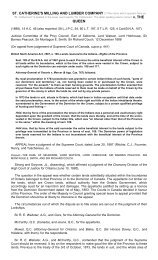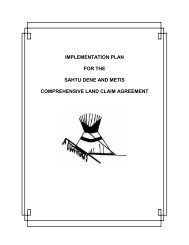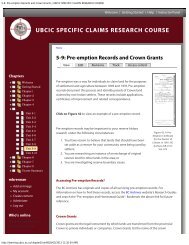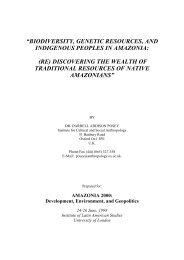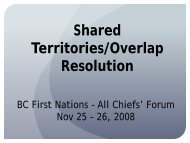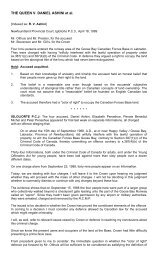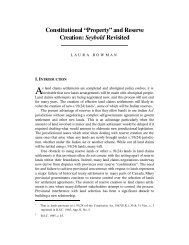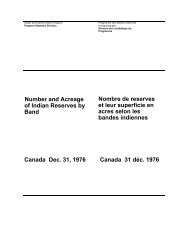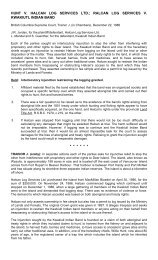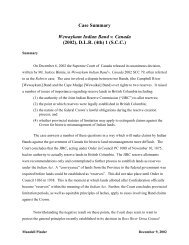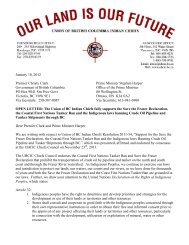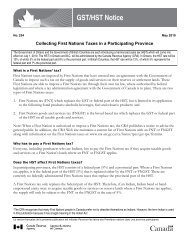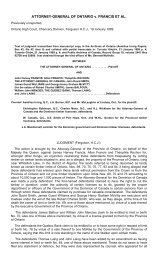ATTORNEY GENERAL for ONTARIO (Respondent) v. BEAR ...
ATTORNEY GENERAL for ONTARIO (Respondent) v. BEAR ...
ATTORNEY GENERAL for ONTARIO (Respondent) v. BEAR ...
Create successful ePaper yourself
Turn your PDF publications into a flip-book with our unique Google optimized e-Paper software.
The grouping of the signing is significant. Tawgaiwene signed the treaty fifth followed immediatelyby Shabokishick and Dokis. There is added as an apparent afterthought, "and also ChiefMaisquawzo" and other named chiefs. Chief Maisquawzo is the only signatory to the treaty whodid not receive a reserve. He was Tawgaiwene's brother-in-law. At the time of the treaty he wasliving on Manitoulin Island. He is listed as having received Imperial presents from 1848 to 1852.He died on December 17, 1853 at Wequamikong on Manitoulin Island where Tawgaiwene and hisson Jocko still lived.An examination of the accounting by Robinson on September 26, 1850, to the ExecutiveCommittee of the Council and hence to the Legislative Assembly is instructive. It shows as paid to"Nebenegwune and Band" on September 13 the sum of £112 5s and refers to voucher No.11.Voucher No.11 has this total broken down into dollars and includes in the following order:Nebenegwune (head man) $25.00Tawgaiwene, Chief $25.00Dokis (Near Lake Nipissing) head man $25.00Maisquawzo, Chief $25.00Shabokeshick's payments are shown on voucher No.12 and Mishequanga's on voucher No.6. It issignificant that all four chiefs and head men on voucher No.11 received the same amount. It alsowill become significant that the voucher represents payments to 96 persons. The court was takenin detail through payments made under the treaty in cash and kind until they ceased so far asNebenegwune was concerned in 1856. The relationship among these four, the size of the band,and the gross amount paid seem to remain constant. In particular, there appears to be always aclose connection between Tawgaiwene and Nebenegwune so far as Ironside at least wasconcerned. In two vouchers <strong>for</strong> payments under the treaty, Tawgaiwene and Nebenegwune arebracketed and shown as being from Wanapitei, the location of the reservation provided toTawgaiwene by the treaty.As indicated earlier, Tawgaiwene had no connection with the treaty area except <strong>for</strong> his residenceon Manitoulin Island. He had no association with Lake Wanapitei but there is evidence that theTemagami Band of Nebenegwune did. In 1880, Charles Skene, the local officer of Indian Affairs atParry Sound, was asked by his superior to determine from the then chief of the Temagami Band,Chief Tonene, what were the hunting grounds of his band. Tonene wag the son-in-law ofNebenegwune. From a department map provided by Skene, Tonene indicated the band's huntinggrounds which clearly showed Lake Wanapitei and Lake Temagami. Skene then drew a map ofthose hunting grounds and in turn showed it to his guide Gilbert Pawis, a signatory to the treaty,who made some corrections in it. He showed it to "several of the Lake Nipissing Indians who knowthe country" and they agreed with its accuracy. All were in agreement that Lake Wanapitei wasincluded in the Temagami Band hunting grounds.On the basis of the <strong>for</strong>egoing facts we fail to see how it can be said that the trial judge made apalpable and overriding error in coming to the conclusion that the Temagami were signatories tothe Robinson-Huron Treaty. On the contrary, we think he was right in so concluding.2. Extinguishment by Adhesion to the Robinson-Huron TreatyAlthough Steele J. Found that the Temagami Band was bound by the Robinson-Huron Treaty as asignatory, he went on to find that even if the Temagami Band was not a signatory it was boundbecause the band later became a party or adhered to the treaty.(a)Annuity paymentsThe evidence is clear that on September 13, 1850, Nebenegwune was paid pursuant to the treaty.Although there is some evidence that the payments may have extended <strong>for</strong> a longer period of time,it is clear that at least until 1856 the Temagami Band was paid in either money or in goods througheither Nebenegwune or Tawgaiwene pursuant to the treaty. Following 1856 or thereabouts, thereare no government records that anyone on behalf of the Temagami Indians came to collect thetreaty money.In 1864, however, Kakake, then chief of the Temagami Band, wrote to the local officer of IndianAffairs at Manitowaning asking <strong>for</strong> payments that he had always received when Ironside was alive.It does not appear that payments were made. Later, in the 1 870s Chief Tonene of the Temagamiapproached the local officer of Indian Affairs at Parry Sound asking that the band again be paid themoney that it had received in earlier years. Again, no action resulted from this request. It appearsthat by about 1880 the officials of the Department of Indian Affairs had concluded that the



